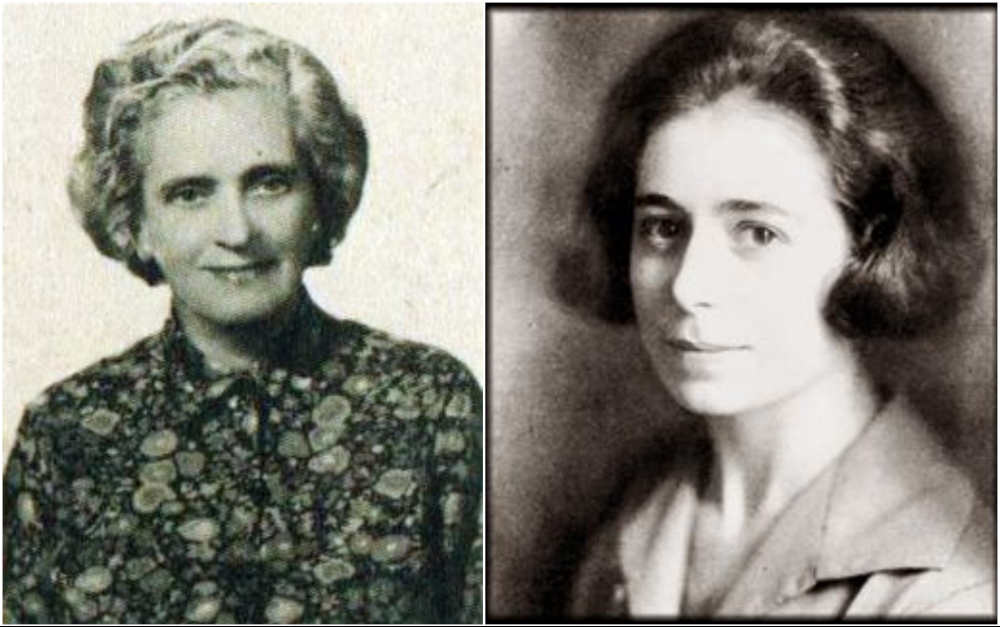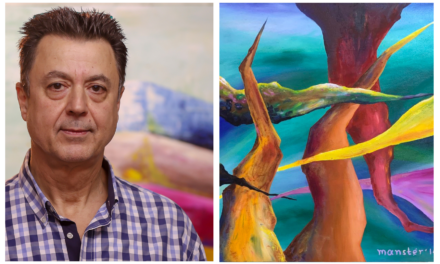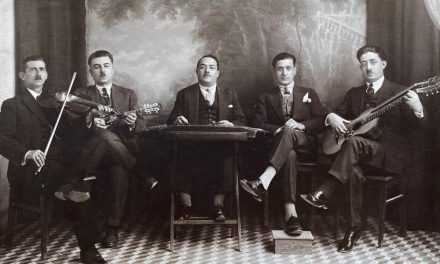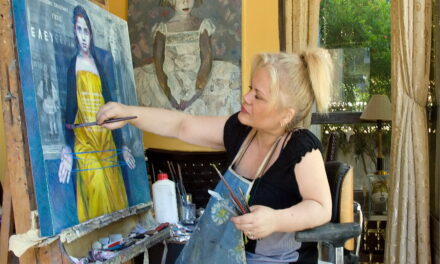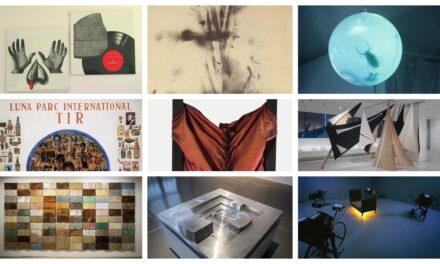Greek News Agenda publishes an article by Dr. Alexandra Kouroutaki* written on the occasion of the celebrations for the Bicentenary of the Greek Revolution (in accordance with the third of the four pillars set by the Committee “Greece 2021”: “Greeks who left their mark on the world in the last 200 years”). The article focuses on a euphoric journey to interwar Crete through the art of two important figures of the previous century. On the one hand, Thalia Kalligianni (1906-1988), an intellectual of Cretan origin who, through her multifaceted literary and editorial work, left her mark on the fields of letters and arts in Greece and Crete, and, on the other hand, Nelly’s – Elli Sougioultzoglou-Seraidari (1899-1998), a famous Greek photographer of worldwide renown.
Introduction
This article attempts a journey to Interwar Crete through the work of two important visual artists of the previous century: Thalia Kalligianni (1906-1988), an intellectual from Crete, who left her imprint on the arts and letters in Grete and Greece through her multifaceted work in the fields of literature and publishing, among others; and Elli Sougioultzoglou-Seraidari (1899-1998), known as Nelly’s, a famous Greek photographer of worldwide renown.
The study aims to present the idyllic image of Crete and its rural and coastal landscapes, highlighting at the same time elements of collective memory, cultural heritage and tradition in Crete, through Kalligianni’ s naïve art and Nelly’s old black-and-white photographs.
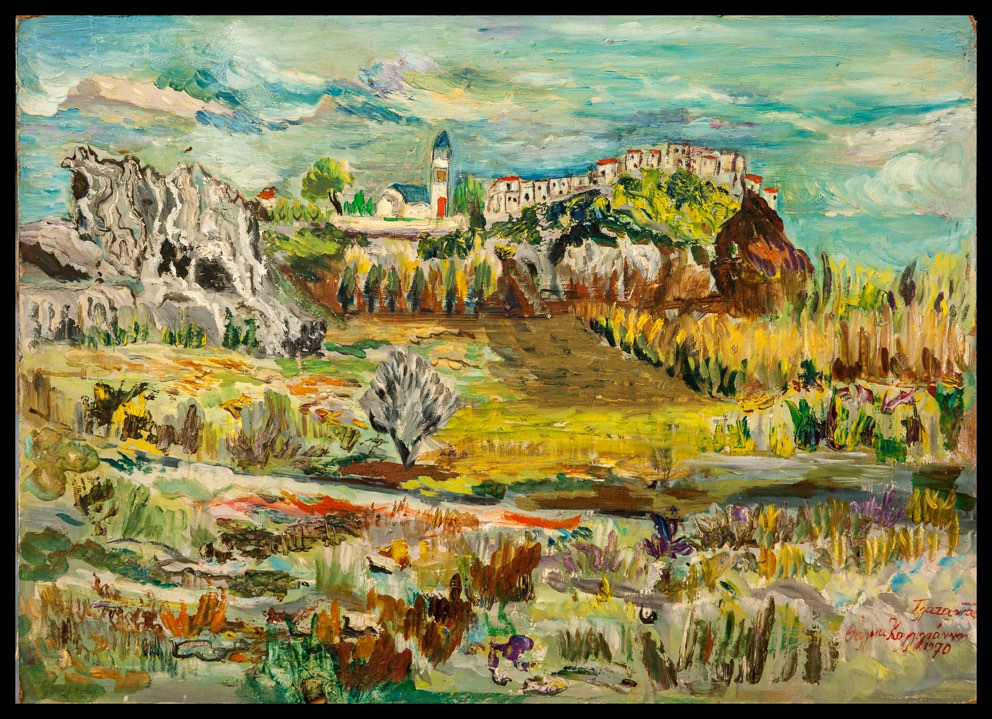 Thalia Kalligianni, Landscape of Platanias, 1970, oil on canvas (Municipal Gallery of Chania)
Thalia Kalligianni, Landscape of Platanias, 1970, oil on canvas (Municipal Gallery of Chania)
The study’s aim is to identify points of common ground in their artistic approach, drawing a line between the subjectivism and esotericism in Kalligianni’ s naïve paintings and the pictorialist aesthetic of Nelly’s photographs, which is achieved through an emotional investment in the subject and an emphasis on the photographer’s vision. Nelly’s in fact tried to place the artistic act at the very heart of the photographic process, proposing a depiction of reality that favours the sensitivity of the artist-photographer.
The study consists of two parts. In the first part the focus is placed on the special relationship that both women had with Crete; Kalligianni’s naïve art (oil and watercolour paintings) and Nelly’s photographs capturing Cretan landscapes are then presented. In the second part, the works by Kalligianni and Nelly’s that represent everyday life in Crete are approached from an ethnographic point of view. Their work is considered to be an historic and ethnographic testimony, conveying the atmosphere of an idyllic Crete in the first half of 20th century.
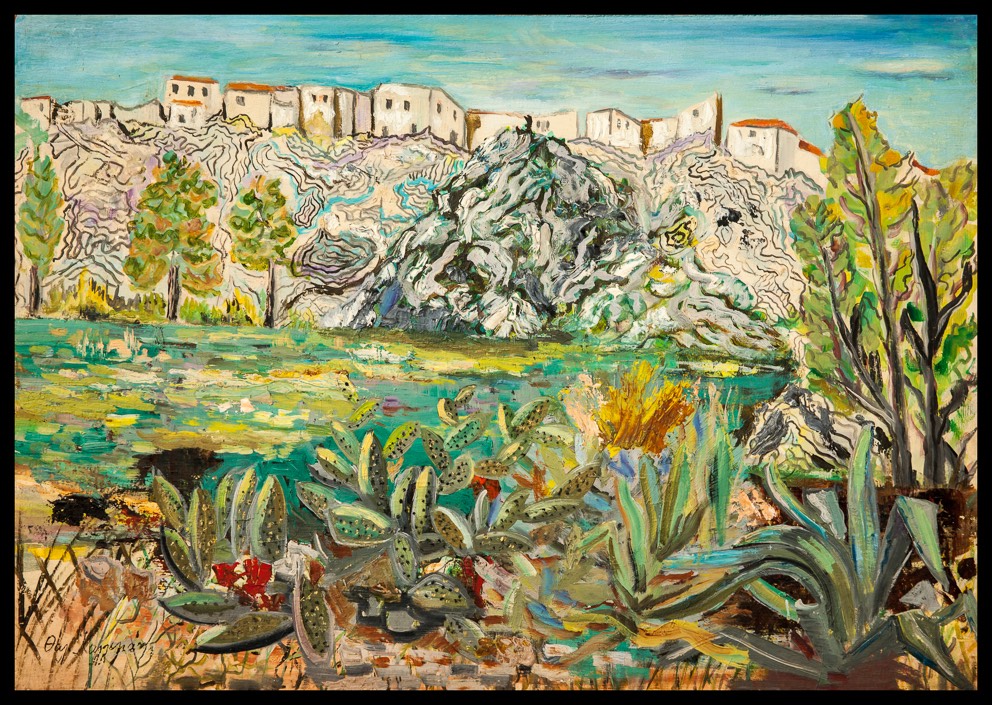 Thalia Kalligianni, Landscape of Platanias, oil on canvas (Municipal Gallery of Chania)
Thalia Kalligianni, Landscape of Platanias, oil on canvas (Municipal Gallery of Chania)
Cretan rural and coastal landscapes
According to her handwritten autobiography, Thalia Kalligianni was born in Chania in 1906, when Crete was an autonomous state. She forged strong ties with the region of Platanias, her father’s place of origin (Fraggakis:2003). Kalligianni was a writer, journalist, editor of the literary magazine Cretan Pages (Kartsakis:2017) and a nearly self-taught painter. She donated almost all of her paintings to the Municipal Art Gallery of Chania.
Kalligianni’s pictorial universe illustrates her experiences and her childhood images in Crete. Her paintings invite us on a journey across time; they call us to stroll along the fertile plains of Platanias, to mentally roam through the olive and orange groves and to gaze at the Cretan rural landscapes with the old stone houses, adorned with flowers and ornamental plants.
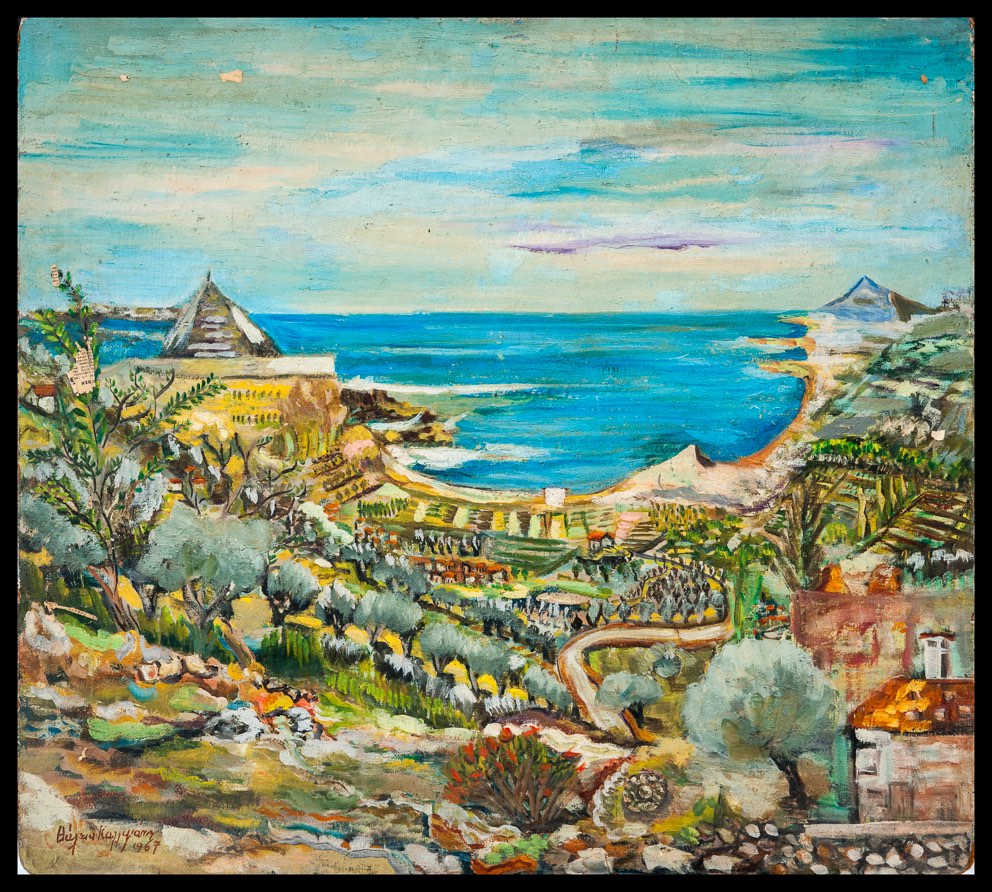 Thalia Kalligianni, Landscape of Platanias, 1967, oil on canvas (Municipal Gallery of Chania)
Thalia Kalligianni, Landscape of Platanias, 1967, oil on canvas (Municipal Gallery of Chania)
Kalligianni’s artistic talent showed up early, but it wasn’t until she moved to Athens in 1939 that she took up painting systematically (Kalligianni 1967). Her naïve art basically obeys an impulse. Guided by instinct, she follows her inner impetus to spontaneously illustrate her memories in paintings. She paints to highlight the impact of reality on her soul. In place of visual realism, she propounds inner realism: the outside world only exists as long as her soul creates it. (Kouroutaki:2021). After all, the subjective perception of reality is a characteristic of naïve painting as a whole (Lydakis:2002, 13).
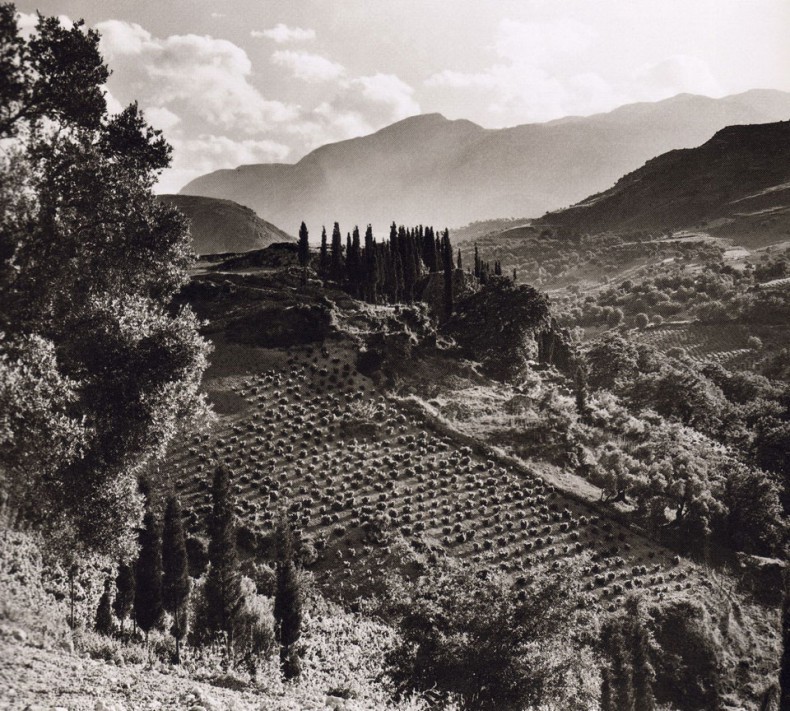 Nelly’s, Lakkoi, Crete, 1927 (Faces of Crete [photographic archives of the Benaki Museum])
Nelly’s, Lakkoi, Crete, 1927 (Faces of Crete [photographic archives of the Benaki Museum])
Kalligianni’s work ingenuously and spontaneously immerses in the rustic and rural landscapes of western Crete, dominated by olive trees with ancient trunks, blooming almond trees, prickly pears, grazing animals, rivers and stone chapels.
Worth of mention is her skill in synthesis and ability to put on canvas all the elements that make up her earthly paradise, while always maintaining the perspective, despite technical difficulties. It must however be noted that, even if the presence of natural elements (the trees and the mountain) is dominant in her landscapes, she captures space with a fascinating esotericism. We consider the colourful and intense atmosphere, the idiosyncratic composition related to emotions and the decorative tendency as clear proofs of the esotericism in her naïve art.
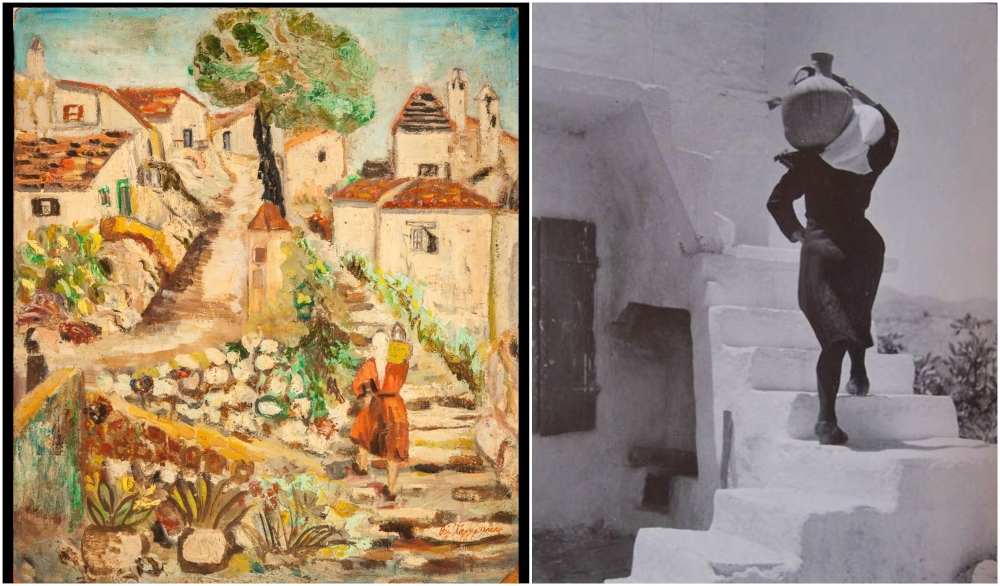 Left: Thalia Kalligianni, Landscape, oil on canvas (Municipal Gallery of Chania); Right: Nelly’s, 1939 (Faces of Crete [photographic archives of the Benaki Museum])
Left: Thalia Kalligianni, Landscape, oil on canvas (Municipal Gallery of Chania); Right: Nelly’s, 1939 (Faces of Crete [photographic archives of the Benaki Museum])
Kalligianni indeed seeks to go beyond the naturalistic approach, favours impression and proposes an inner realism corresponding to her emotion, through appropriate light and poetic colours (Kouroutaki, 2021). Her canvases are always bathed in sunlight. She is particularly interested in capturing the atmosphere of the scene depending on the time of the day, the season and the weather conditions. But she almost always prefers spring, the Naïves’ favourite season.
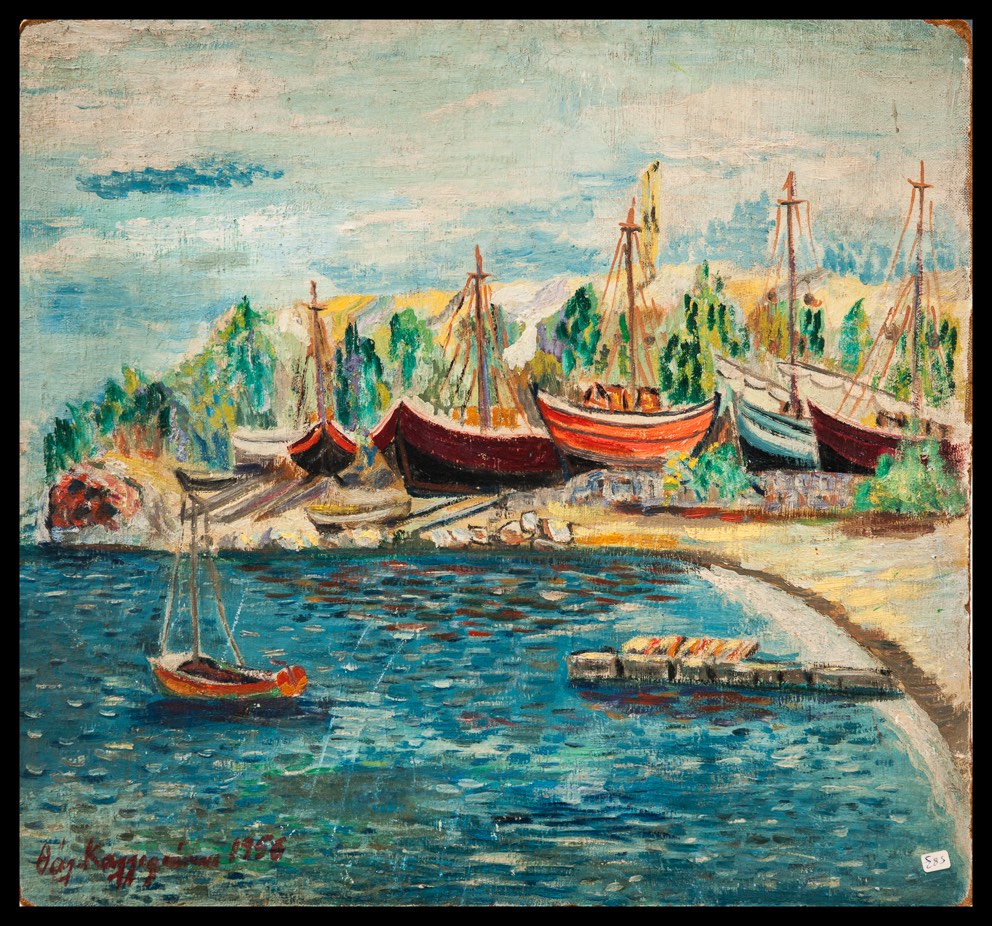 Thalia Kalligianni, Harbour, 1956, oil on canvas (Municipal Gallery of Chania)
Thalia Kalligianni, Harbour, 1956, oil on canvas (Municipal Gallery of Chania)
Stone, wood and tiles are Kalligianni’s means of depicting the houses of Platania. Insisting on details she builds, stone by stone, walls, courtyards and gardens. She shows special interest in rendering the various flowers and plants that bloom in Platanias, in the heart of spring. Occasionally, she incorporates figures of female farmers. Her veduta displays childish simplicity and ingenuousness. However, she pays great attention to the play of light and shadow and she prefers to use warm, earthly colours contrasting with the whitewashed houses.
Elli Sougioultzoglou-Seraidari (1899-1998) is known under the moniker Nelly’s. Thanks to her artistic photographs she contributed to the creation of an image of Greece in the Western mind. (Panayotopoulos: no date). She was born in Aydin, near Smyrna (modern day Izmir) in Asia Minor. She studied photography in Germany under Hugo Erfurth and Franz Fiedler, (1920-1921) before the 1922 expulsion of Greeks from Asia Minor, following the Greco-Turkish War (1919-1922). She came to Greece in 1924 and she adopted an approach that coincided with the Greek state’s need to project an ideal image of the country and its people for both domestic and international use.
As a Diaspora Greek, Nelly’s view of Greece was nothing less than “idyllic” In 1985 she donated her photo archives and cameras to the Benaki Museum in Athens, while in 1987 she was presented with an honorary diploma by the Hellenic Centre for Photography. In 1993 she was named a Commander of the Order of the Phoenix by the president of Hellenic Republic. In 1996 the Academy of Athens bestowed on her the “Arts and Letters Award”.
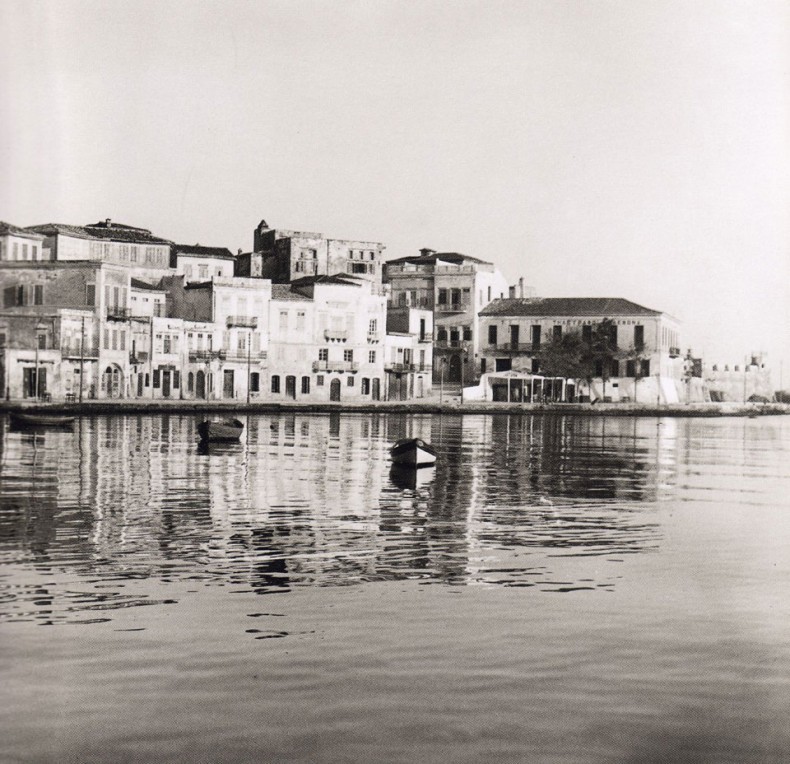 Nelly’s, Venetian harbour of Chania, 1927, © Nelly’s
Nelly’s, Venetian harbour of Chania, 1927, © Nelly’s
As part of her collaboration with the Hellenic Ministry of Tourism, Nelly`s visited Crete twice, in 1927 and in 1939, to capture snapshots of the Cretans’ life in the cities and villages. These photographs are published in the album Faces of Crete (2004, photographic archives of the Benaki Museum in Athens). These photographs serve as testimony to the Cretan landscape’s idyllic beauty and serenity.
In her photographic work she tried to capture the wildness and beauty of the Cretan landscape. Country life, male and female farmers, daily chores, local folk costumes, customs and traditions as well as the preparation of foods became her favourite subjects. Though she explores traditional artistic genres as portraiture, landscape or architectural view, her photographs can be described as “pictorialist” as they aim to highlight the photographer’s vision and “transform” reality with the aid of various techniques, such as chiaroscuro effects, diagonal shots and shots in perspective, or cropping the picture.
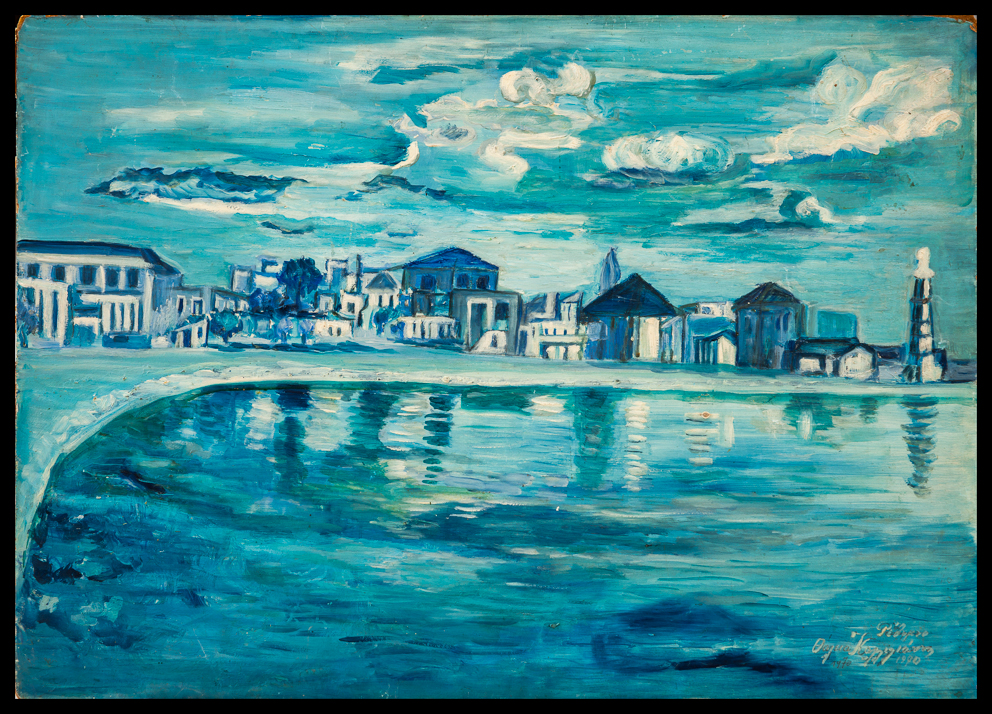 Thalia Kalligianni, Landscape, 1970, oil on canvas (Municipal Gallery of Chania)
Thalia Kalligianni, Landscape, 1970, oil on canvas (Municipal Gallery of Chania)
The subjectivity emerging from her photographs is perceived through the disruption of reality (Koskina:2008). Nelly’s does not hesitate to tamper with the form – as, for example, the volume of a house in the country through a light source on the stairway, aiming to depict better the dynamic of the architecture. Due to her training in painting, she was aware of the crucial role of lighting in conveying form. In her photographs, she uses light to reveal the deepest nature of the forms (Koskina:2008) as is done in painting. Also worth noting is her choice of a bottom up perspective. The intensity and power of her shots, diagonal or in perspective, the play of light, the shadow contrasts, give to her photographic work a “pictorialist” quality.
 Left: Thalia Kalligianni, Fishermen, oil on canvas (Municipal Gallery of Chania); Right: Nelly’s, Venetian harbour of Chania, 1939 (Faces of Crete [photographic archives of the Benaki Museum])
Left: Thalia Kalligianni, Fishermen, oil on canvas (Municipal Gallery of Chania); Right: Nelly’s, Venetian harbour of Chania, 1939 (Faces of Crete [photographic archives of the Benaki Museum])
In her seascapes, Kalligianni especially liked painting fishing boats and fishermen at work. Her intention was to create a sincere narration. Stylisation is ubiquitous in these canvases: fishing boats are always seen from the side, and the rows of houses by the sea are reminiscent of children’s drawings. She seems particularly concerned with the depiction of the sea; she portrays it using either dark or light blue. She uses swells of deep blue to represent waves, while the foam is shown with white brush strokes, in harmony with the cloudy sky. She even manages to illustrate the water’s transparency and the play of light on the water surface, the boats and the houses. Her seascapes are bathed in Mediterranean sunlight to correspond with her emotions.
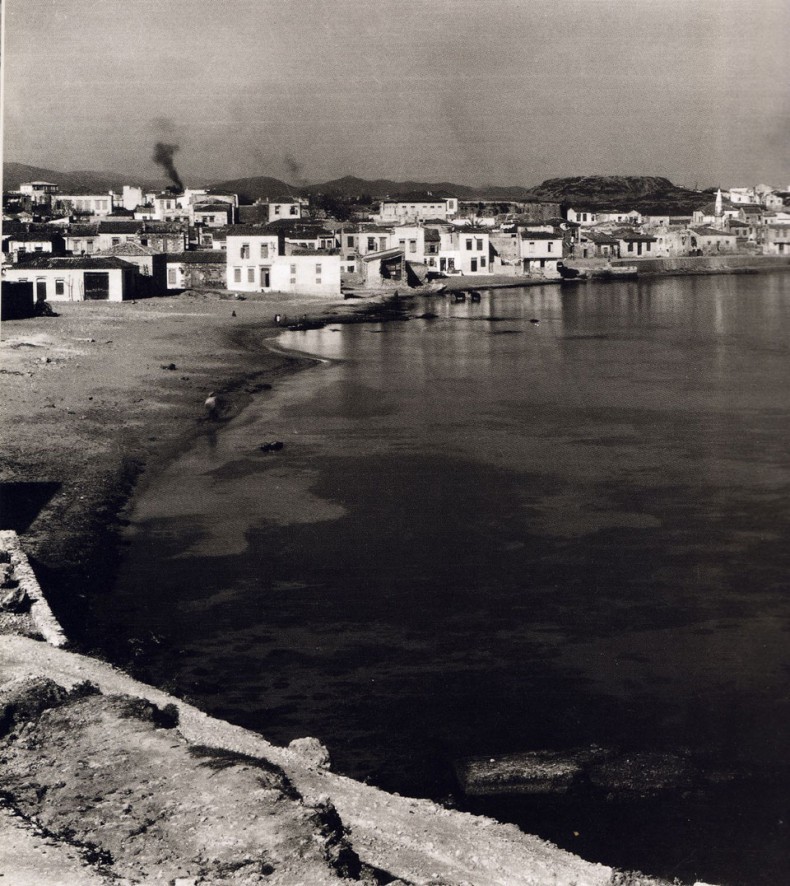 Nelly’s, Koum Kapi Beach, Chania, 1927 (Faces of Crete [photographic archives of the Benaki Museum])
Nelly’s, Koum Kapi Beach, Chania, 1927 (Faces of Crete [photographic archives of the Benaki Museum])
Likewise, in Nelly’s photographs, the subjective element can be found in the pivotal role given to light and the play of light, seen through an aesthetic or even conceptual prism. It seems that Nelly’s does not seek realistic precision in photography. She pays particular attention to the photograph’s aesthetic quality as a means of expression of her relation to the world, and places emphasis on the photographer’s impression and vision.
Naïve painting and ethnographic photography
In the second part of the article, the focus is placed on the ethnographic interest of Kalligianni’s naïve art and Nelly’s photographs presenting everyday life scenes from Crete and portraying Cretans in their traditional costumes.
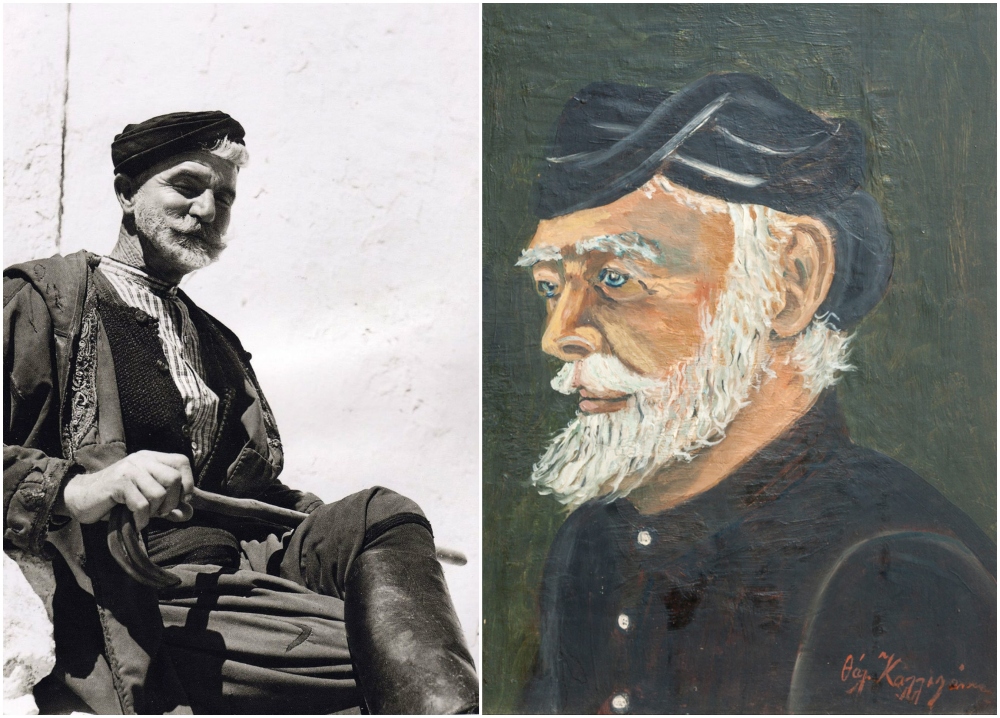 Left: Nelly’s, portrait, (Faces of Crete [photographic archives of the Benaki Museum]); Right: Thalia Kalligianni, portrait, oil on canvas (Municipal Gallery of Chania)
Left: Nelly’s, portrait, (Faces of Crete [photographic archives of the Benaki Museum]); Right: Thalia Kalligianni, portrait, oil on canvas (Municipal Gallery of Chania)
Through her paintings, Kalligianni mentally returns to Platanias in order to join in the carefree life and the popular traditions of the village. Her paintings, which portray Crete’s customs and traditions, have undeniable ethnographic interest. They are distinguished by a chromatic lyricism evocative of her nostalgia for her childhood paradise.
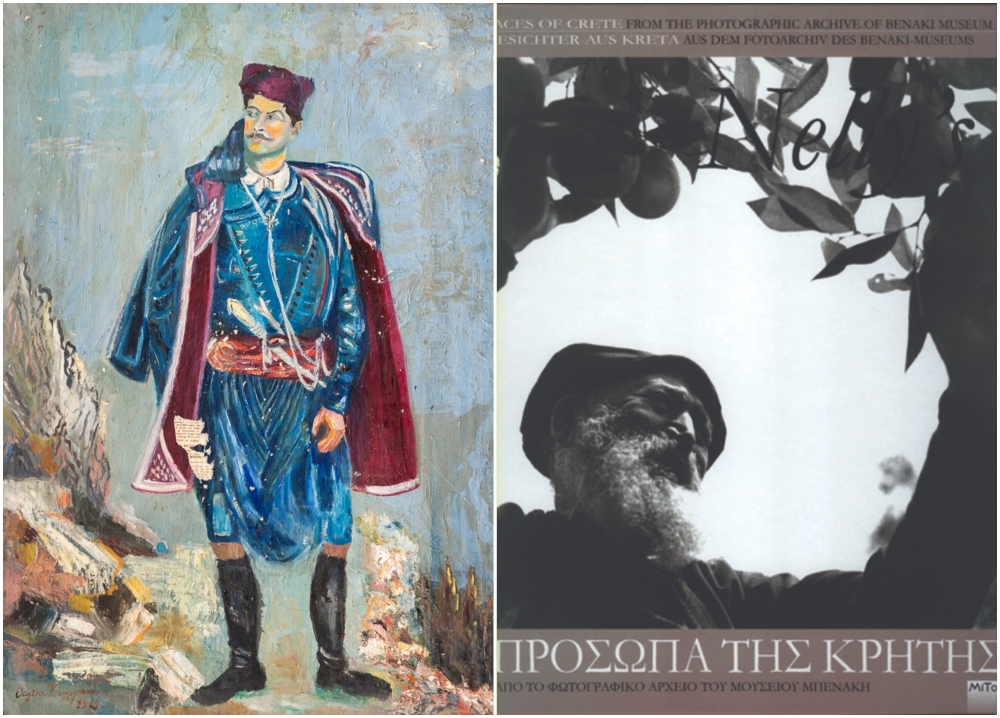 Left: Thalia Kalligianni, portrait, 1969, oil on canvas (Municipal Gallery of Chania); Right: Nelly’s, cover of Faces of Crete, 2004 , Mitos editions[photographic archives of the Benaki Museum]
Left: Thalia Kalligianni, portrait, 1969, oil on canvas (Municipal Gallery of Chania); Right: Nelly’s, cover of Faces of Crete, 2004 , Mitos editions[photographic archives of the Benaki Museum]
Despite technical difficulties, Kalligianni does not hesitate to portray Cretans dressed in their local costumes. These portraits are so lifelike that a physiognomist could deduce the true character of the subjects, and the Cretans’ moderate, reflective and wise disposition. She particularly tries to capture the subjects’ mood through their expression, with an emphasis on their eyes. The traditional Cretan attire is meticulously and accurately depicted in Kaligianni’s portraits.
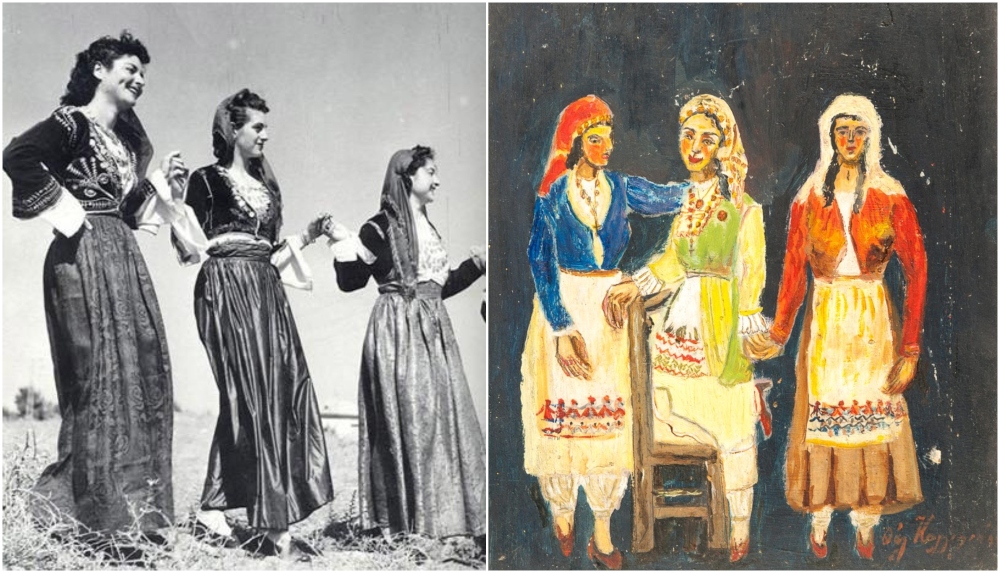 Left: Nelly’s, women, (Faces of Crete [photographic archives of the Benaki Museum]); Right: Thalia Kalligianni, three Cretan girls, 1969, oil on canvas (Municipal Gallery of Chania)
Left: Nelly’s, women, (Faces of Crete [photographic archives of the Benaki Museum]); Right: Thalia Kalligianni, three Cretan girls, 1969, oil on canvas (Municipal Gallery of Chania)
Old photos and postcards from the early 20th century are a constant source of information and inspiration for the artist. In her canvases, Cretans wear a white shirt, a vest, loose-fitting salvar-like trousers (vraka), a long silk belt wrapped several times around the waist, a headscarf with fringes (sariki) and black boots. A steel blade knife is also considered an essential part of the traditional attire. It is worth noting that the shirts and cuffs are completely buttoned up as a sign of mourning for Crete, which had witnessed continuous revolutions against the Ottoman Empire throughout the 19th century, until its eventual union with Greece in 1913. Kalligianni’s works also invite us to celebrate the saints’ feast days, to join groups of merry dancers and musicians and listen to the tunes of the traditional lyra and lute. Likewise, Nelly’s tries to capture in her photographs the Cretans’ disposition reflected in their faces and postures.
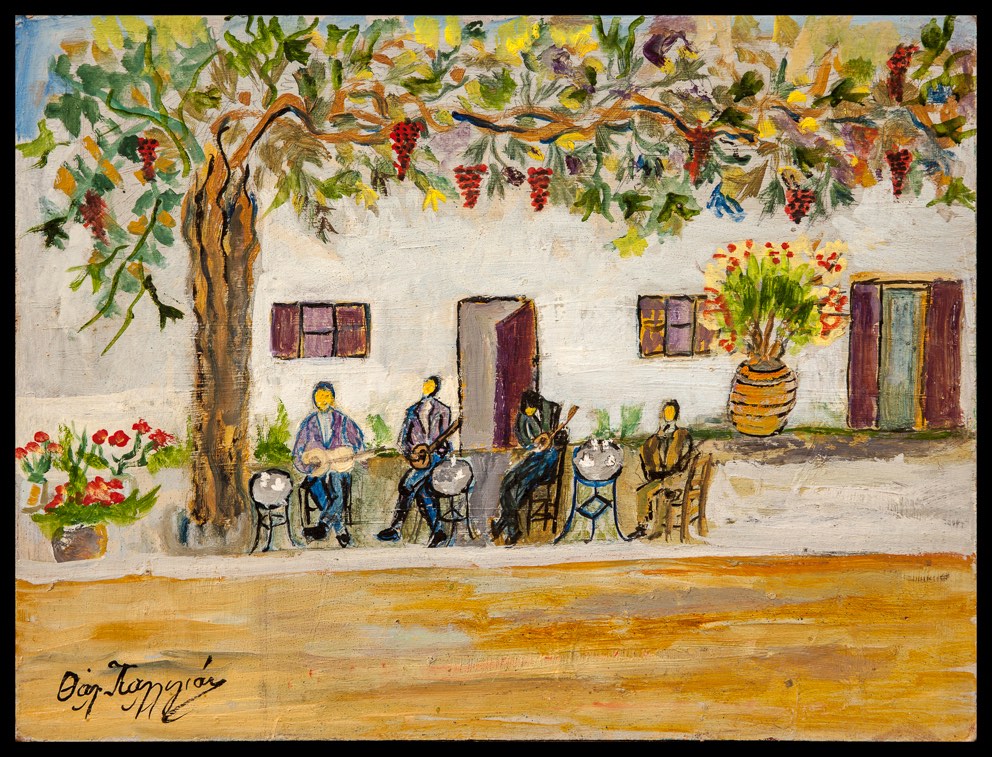 Thalia Kalligianni, musicians, 1969, oil on canvas (Municipal Gallery of Chania)
Thalia Kalligianni, musicians, 1969, oil on canvas (Municipal Gallery of Chania)
Women’s traditional dress, which forms part of the Cretan cultural identity, also inspired Kalligianni. In one of her works we see three young Cretan women dressed in festive costumes from western Crete, depicted in great detail. They consist of a pleated skirt, a white shirt and a multi-coloured V-neck waistcoat. Kalligianni also shows the other clothing elements, such as the headscarf, either wrapped around the head or hanging loosely over the shoulders, and the intricately embroidered white apron. The festivities of her village are among Kalligianni’s favourite subjects. In short, we are invited to dive into Crete’s popular tradition, folklore, myths and culture.
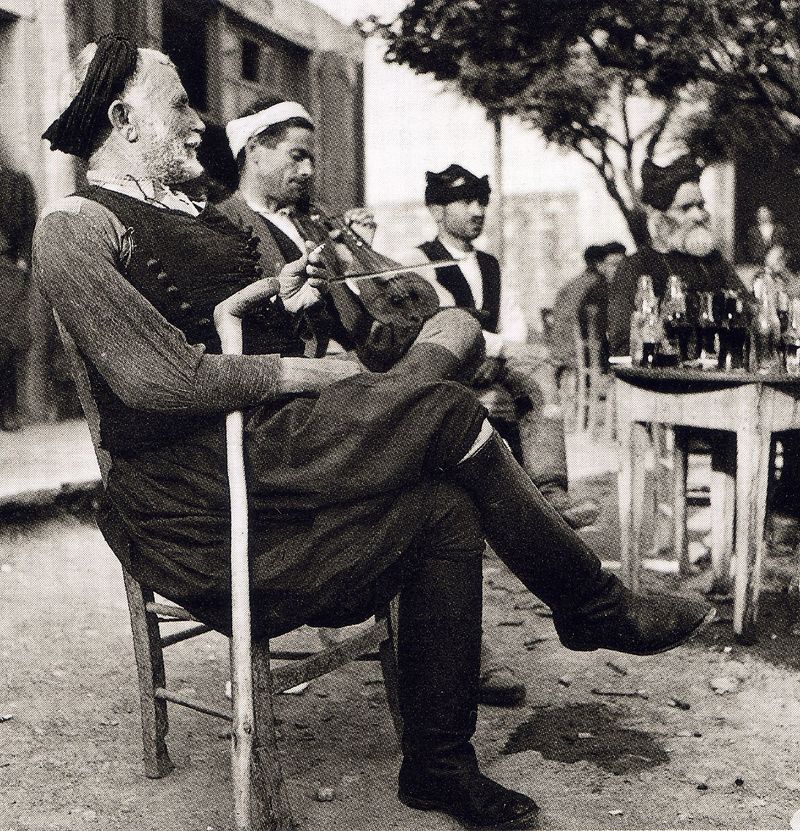 Nelly’s, 1939, (Faces of Crete [photographic archives of the Benaki Museum])
Nelly’s, 1939, (Faces of Crete [photographic archives of the Benaki Museum])
Kalligianni also depicts farm work in Crete in a tondo which shows Cretan female farmers harvesting wheat. In this painting we can appreciate her ability to create perspective through the diminishing size of the figures. The composition is characterized by the sense of movement and colour unity this, creating a festive atmosphere reminiscent of the good old times, what the naïve artists evoke as the “golden years”. The photographic portraits of Nelly’s are also shot against a particularly idyllic natural background scenery. Her camera captures the psyche and spirituality of the Cretans through their facial expressions. She also uses diagonal shots and makes the most out of the use of perspective and the play of light and shadow.
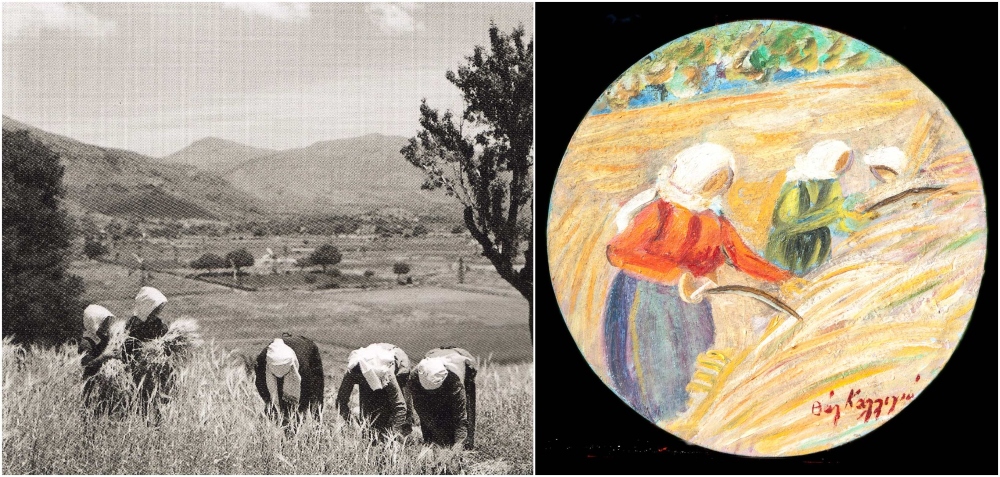 Left: Nelly’s, Messara, 1939, (Faces of Crete [photographic archives of the Benaki Museum]); Right: Thalia Kalligianni, harvest, oil on canvas (Municipal Gallery of Chania)
Left: Nelly’s, Messara, 1939, (Faces of Crete [photographic archives of the Benaki Museum]); Right: Thalia Kalligianni, harvest, oil on canvas (Municipal Gallery of Chania)
Conclusion
The study of Kalligianni’s painting leads to the following conclusions: As far as her themes are concerned, the artist has a broad range of subjects, drawing inspiration from the first half of the 20th century in Crete. She has created a colourful panorama of the island’s folklore, landscapes and culture, portrayals of Cretan people and depictions of everyday life scenes from Platanias. Her intuitive, spontaneous, sincere and emotional art originates from her profound need to express her emotions. The main features of her naïve art are the simplicity of her style, the use of great detail, penchant for storytelling, the decorative quality of her work and and her ability to draw an immediate reaction from the viewer.
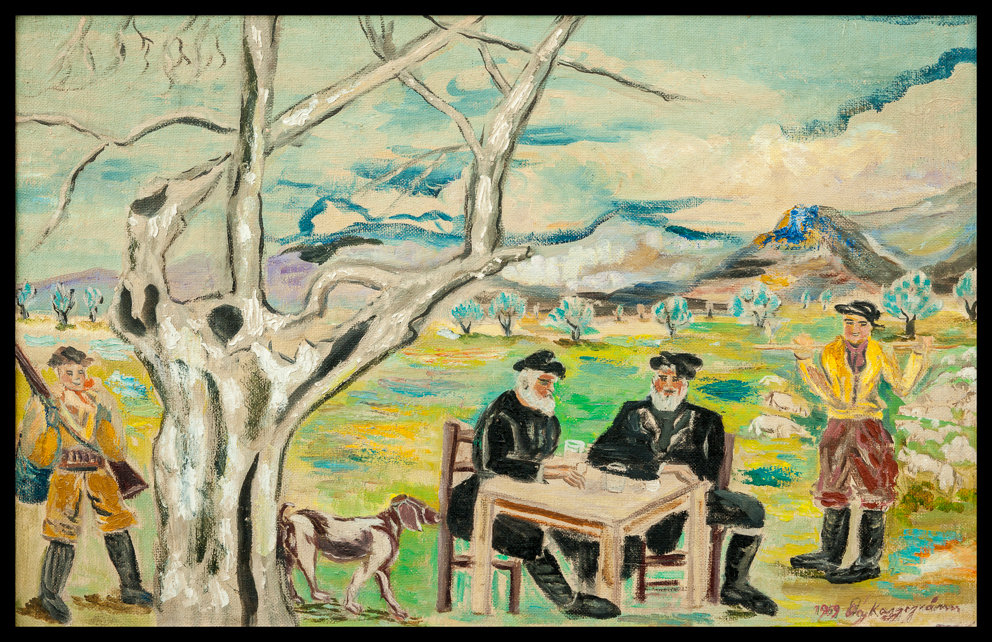 Thalia Kalligianni, shepherds, 1969, oil on canvas (Municipal Gallery of Chania)
Thalia Kalligianni, shepherds, 1969, oil on canvas (Municipal Gallery of Chania)
With regard to style, Kalligianni’s painting fulfills the criteria for naïve art, as laid down by Robert Thilmany in his study Critériologie de l’art naïf (1984: 26). Her works emanate the “scent of innocence” and are distinguished by a freshness and candidness reminiscent of children’s drawings. Innocence, even in the sense of the simplification of the shapes, allows Kalligianni to overcome technical difficulties. Other features of Kalligianni’s art concern her proneness for idealisation, manifesting deep unconscious tendencies (Thilmany:1984, 28). Kalligianni’s ingenuousness is associated with a remarkable instinctive technique in her compositions and use of colours. She pays attention to every detail and reveals a surprising ability for synthesis. Colours appear emotionally charged, demonstrate painter’s involvement in her subjects.
Nelly’s, 1939, (Faces of Crete [photographic archives of the Benaki Museum])
On the other hand, it is important to point out the lyricism that emanates from Nelly’s photographs and their pictorialist esthetic quality. It should be noted that Nelly’s received an artistic education in music and painting. Despite the “classic” approach of most of her subjects and the use of excellent technique, she rediscovers photography as a “luminous” image, which has to correspond to her profound emotion and subjective vision. It is thanks to this pictorialist aesthetic that her photographs have acquired the status of works of art.
*Source: Kouroutaki, Alexandra Thalia Kalligianni (1906-1988) “Painting from the heart”. Her pictorial world, her relationship with Platanias and the uniqueness of a naïve expression, ed. Municipal Art Gallery of Chania in collaboration with the Municipalities of Chania and Platanias, June 2021.
Bibliography
Fraggakis, T., 2003, Platanias in History and Memories, unpublished, Chania.
Kalligianni, T., Undated, Handwritten autobiography, Archives of the Municipal Library of Chania.
Kalligianni, T., 1967, Brief Biographical Note, Agency for Intellectual Cooperation, no. 41.
Kalligianni, T., 1962, Nathalia, The Great Guilt, Chronicle of Life, unpublished, Athens.
Kartsakis, A., 2017, “Heraklion during the Interwar Period”, lecture in the conference circle “The Myth of Ariadne. Unveiling the history of the city of Heraklion, 20 years later”, Manolis Karellis Hall, Heraklion City Hall.
Kartsakis, A., 2014, Literary Heraklion in the Interwar Period: Texts, Publications, Creators, Vikelaia Municipal Library, Heraklion, Crete.
Koskina, K., “Athens – Retrospective photographic exhibition of Nelly’s work in New York (1899-1998)”, 2008. http://www.artopos.org/artists/nellys/nelly1-gr.html
Kouroutaki, A., Thalia Kalligianni (1906-1988) “Painting from the heart”. Her pictorial world, her relationship with Platanias and the uniqueness of a naïve expression, ed. Municipal Art Gallery of Chania in collaboration with the Municipalities of Chania and Platanias, 2021.
Lydakis, S. 2002. Greek naïve painting, Melissa, Panayotis &Effie Michelis Foundation, Athens.
Nelly’s, 2004, Faces of Crete, Mitos, (Benaki Museum photo archive).
Panayotopoulos, Nikos. “The Western gaze and Greek photography: Τhe case of Nelly’s” undated
Thilmany, R., 1984, Critériologie de l’art naïf, Max Fourny, Paris.
(Written in French by A. Kouroutaki, adapted into English by Sofia Dimopoulou and edited by Nefeli Mosaidi. The original has appeared on Grèce Hebdo. Intro image: Photographic portraits of Thalia Kalligianni [left] and Nelly’s [right])
Read also via Greek News Agenda: The Acropolis and the Parthenon in Modern Greek art as symbols of national and world heritage; Art historian Alexandra Kouroutaki on Erotokritos’ intercultural substance and influence on Greek painting; Art historian Alexandra Kouroutaki on Nativity in 20th-century hagiography in Chania

